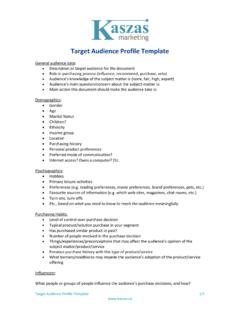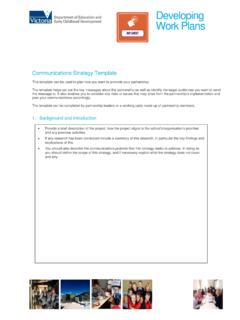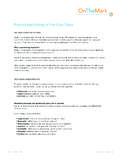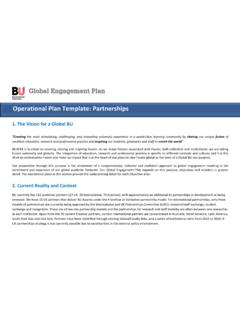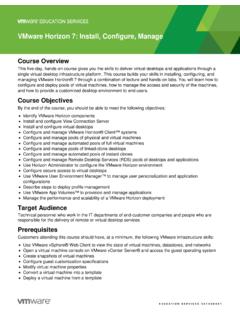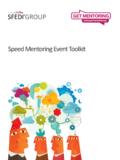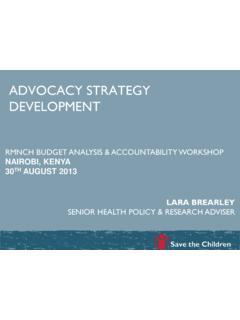Transcription of Strategic Communications Template Worksheet
1 Strategic Communications Template Worksheet This Worksheet was developed to help you form a Strategic Communications plan and is meant to be used in conjunction with the Strategic Communications Template as it follows the same outline. A Communications plan is the overall strategy for reaching the partnership's communication goals for both internal and external partners. The plan consists of the goal, targeted audiences, key messages, smaller action plans for communication initiatives and analysis of all of the partnerships Communications . 1.) Purpose Purpose of a Communications Plan The purpose of a Communications plan is to support the Strategic objectives and provide action items for the Communications of the partnership for the next (amount of time). This plan serves as a guide for all internal and external communication regarding (partnership objectives) for (targeted audiences).
2 2.) Goals Mission of Partnership (What is the mission statement of the partnership?). A mission statement describes what the partnership is going to do and why. It is a way to look at the big picture in a concrete and action oriented way. The mission statement should be: Concise- 1 to 2 sentences Goal Oriented- explains the goals of the partnership Inclusive- the statement should be broad enough to cover all current and potential partners Example: Mission: Graduate is a cradle-to-career education partnership that is focused on system change to help more students graduate from high school, earn a college degree or credential, and enter a career of their choosing in Central New Mexico. Partnership Goals (What are the aspirational goals of the partnership?). The Partnership Goals are the aspirational goals of the partnership.
3 The partnership goals are derived from the mission statement, values, and beliefs of the partnership. It is important that your communication objectives tie directly back to the partnership goals. Examples: Every child succeeds academically. Every child is prepared for kindergarten. communication Objectives (What does the partnership want to achieve through communication ?). communication Objectives are the goals that you would like to achieve through communication . What issues do you wish to address through Communications ? Consider: What tangible outcomes would you like to achieve through your communication effort? How will you know when you achieve your goals? (Be specific). What would you like to see, hear or have in hand that will let you know you are making progress toward your goals?
4 Examples: Our social media efforts engage the community in conversations about education We have a website to keep the community informed and serve as an information resource All partners communicate a clear and consistent message about the partnership 3.) Audience Primary Audience (Whose knowledge, attitudes and behaviors must be changed in order to meet the partnership's goal? This is the audience the messages should be tailored to.). The Primary Audience is the group who Communications will be focused on. Consider: Whose knowledge, attitudes, and behaviors must be changed in order to complete the partnership goals and Communications objectives? What are the characteristics of the audience? (Gender, ethnicity, income, language). What are the barriers and benefits associated with communicating with this audience?
5 Examples: Potential business sector partners; after-school program providers; funders; superintendents; parents Secondary Audience (Who else will be affected if the partnership succeeds in their goal? Keep this audience in mind when crafting messages.). The secondary audience is made up of those who are not the intended target of Communications but will receive the messages or will be affected by the success of the partnership's goals and communication objectives. Consider: Who else might the communication strategies reach and impact? What groups will be directly or indirectly affected by the partnership? Examples: Students; teachers; non-educational community organizations Influencers (Who can help the partnership reach the primary and secondary audience? Allies, partners or influencers).
6 Influencers are those who can help the partnership reach the primary audience. Consider: What partners can help the partnership reach targeted audiences? Who do the targeted audiences find credible? Where do the targeted audiences get their information? Examples: Members of the Leadership Table; local political officials; reporters Audience Knowledge, Barriers & Benefits Profile characteristics attitudes, What are the barriers to this audience Demographics. behaviors fully supporting or participating in What/who are they influenced by? related to issue reaching goal? What are the benefits What or who could motivate if they do? change or action? Example: Audience Knowledge, Barriers & Benefits Profile characteristics attitudes, What are the barriers to this audience Demographics.
7 Behaviors fully supporting or participating in What/who are they influenced by? related to issue reaching goal? What are the benefits What or who could motivate if they do? change or action? Elected Low knowledge of Barriers: Limited time in office, may Demographics: 35-65; majority Officials the Partnership, have other policy priorities male (City Council Skeptical attitude Benefits: Helps move policy change, Influences: Voters, Mayor, Parents & School of success, Limited gives the Partnership credit in the Motivations: Proof the Partnership Board political support community will work and is unique, pressure members) from voters and higher ranking officials (mayor, senior council). 4.) Message Theme (What is the overarching theme for the partnership's messaging?
8 The direction of the messaging.). Themes are the building blocks for messages. They are concise statements about the partnership that you want the overall community to remember. Themes should be memorable, easy to understand and jargon free. Consider: What do you want to communicate about the partnership? Why is the partnership important? Who benefits from the partnership? Why is the partnership unique? What does the partnership do? Example of Themes: All Hands Raised, Portland, OR. Transforming children into educated, independent adults is the job of the entire community. The Partnership has a specific focus on eliminating racial disparities to ensure opportunity and achievement is available to all students. This work is grounded in data with a framework of continuous improvement.
9 Alignment around a common set of indicators and shared practices will get us to community-wide impact. Messages (What does the partnership want their audience to do, think, feel, or change? What are the compelling motivations the audience needs to hear in order to take action? What are barriers for the audience? How should the partnership communicate to the secondary audience (those who are not directly involved, but affected by the outcome)? The answers to these questions are the messages.). Messages are tied to the theme, they deliver important information about the issue while compelling and directing how the targeted audience should think, feel, and act. Quite simply, your messages are what you want to communicate. Different messages will be created for each audience and purpose.
10 Messages can accomplish many things. They can: Show importance or urgency Show the relevance of the issue and the partnership Put a face on the issue Consider What is the purpose of the message: to ask, persuade, thank or inform? Who are the primary and secondary audiences for the message? What will motivate the audience to change their mind or take action? What mood do you want the message to have? What kind of language will your message use? How frequently will you communicate the message? Example: Strive Partnership, Cincinnati, OH. The brain physically grows to 90% of its adult size by age 5. The brain connections that create this growth are primarily based on the experiences a child has in these early years. Quality early childhood education is essential. Like the Preschool Promise page to learn about our efforts in Cincinnati.
